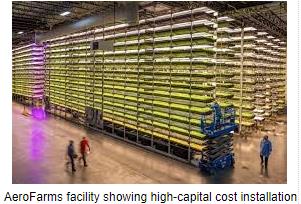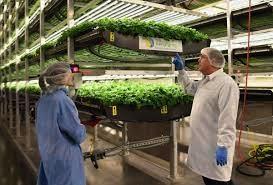The Chapter 11 bankruptcy filing by AeroFarms and AppHarvest highlight the problems experienced by high-tech agriculture. Along with similar companies, indoor cultivation of leafy greens offered the promise of year-round availability, proximity to high-density centers of consumption and freedom from pathogens. Profitability of vertical farming was based on over-optimistic assumptions of implementation and volumes of production coupled with inappropriate levels of consumer demand given high and non-competitive shelf prices. The exponential rise in vertical farming emerged from a concordance between enthusiastic proponents of high-tech agriculture and the desire of venture capital (VC) investors to generate high returns over short periods by disrupting existing production systems. Between aspiration and an overabundance of capital, the common sense evaluation of production costs and margins was ignored. Dr. Ari Ginsberg of New York University noted, “VCs didn’t do their homework on the economics and how long it would take to reach profitability.”

When this commentator visited a newly erected vertical farming operation in 2022 in an industrial complex adjacent to Atlanta Airport, the overwhelming impression was an inordinately high capital cost for equipment and installations required to create an environment suitable to propagate relatively low volumes of lettuce. It was evident that a high level of technical knowledge was necessary to achieve production. Maintenance and operation of equipment was evidently incurring high variable costs and above all, considerable energy input was necessary to illuminate racks of plants and to constantly circulate aqueous solutions of liquid fertilizer. The impression gained was that the enterprise represented technology for the sake of technology. The product still required high labor input for packing. Containers of immature lettuce in PET clamshell packs were essentially less attractive and more expensive than far larger heads trucked to distribution centers from Arizona and California or derived from conventional greenhouses.
Escalation in the cost of energy and capital destroyed the validity of spreadsheets created three years previously when capital was assigned to many of the emerging enterprises. Venture capital companies quickly soured on vertical agriculture, terminating cash spigots that maintained operations until promised scale of production could be achieved.

Some businesses in this aspect of intensive agriculture will survive and even prosper. They are characterized as smaller operations, offering a diversity of products and enjoying close relationships with supermarket chains. Survivors will concentrate on product quality and efficiency while maintaining a balance between traditional and high-tech systems.
In contrast, the egg industry has evolved over decades with adoption of technology consistent with practicality and an anticipation of profitability. Certainly, mistakes have been made along the way including adoption of high-rise housing as a successor to lagoon systems. Storing manure in pits inevitably led to difficulties in current disposal in the face of increasing environmental restrictions. High-rise housing also led to the emergence of SE as an industry problem. Transition to multi-tier aviary housing was a response to the need to transition from conventional cages. Time will be required to overcome inherent difficulties in management of flocks and to establish whether the cost differential compared to conventional cages will be offset by higher unit revenue over the long term.
In order to feed burgeoning populations of the world, agriculture must adopt higher levels of efficiency through genetics and management while maintaining sustainability and compliance with environmental regulations. Moving forward at a slower pace provides an opportunity to identify and correct unpredicted but inevitable difficulties and to adjust to market demands. The rise and demise of vertical farming should serve as a lesson to agriculture limited by biological realties in addition to production and marketing pressures.